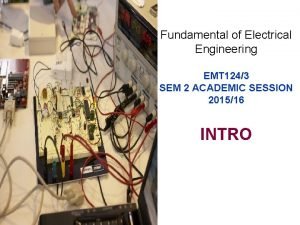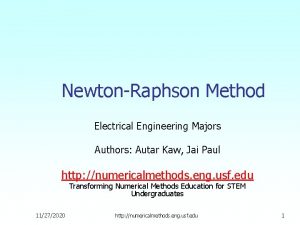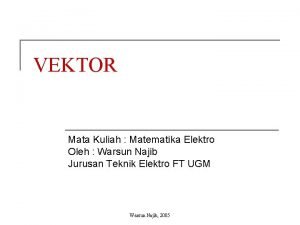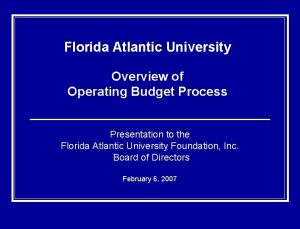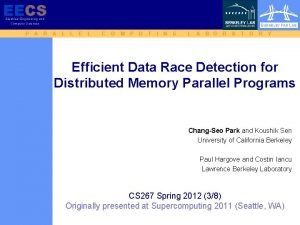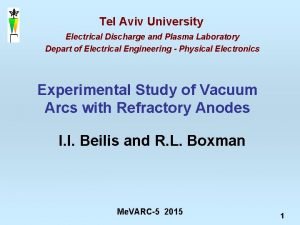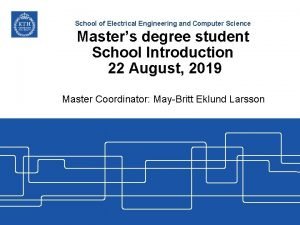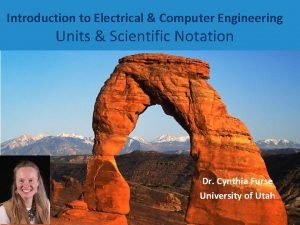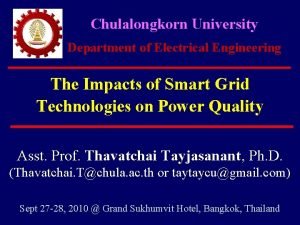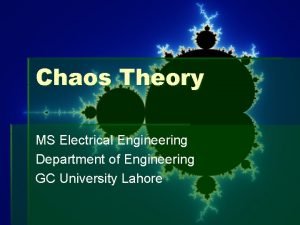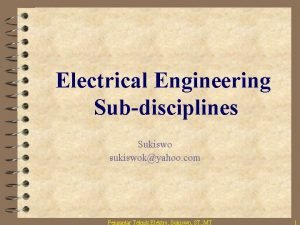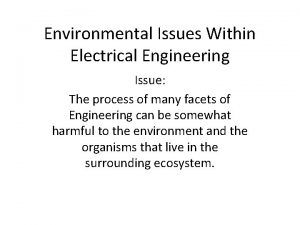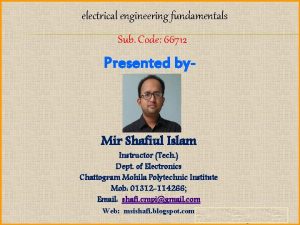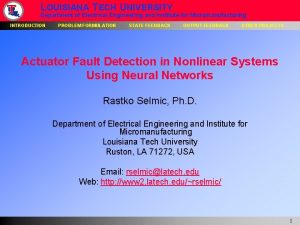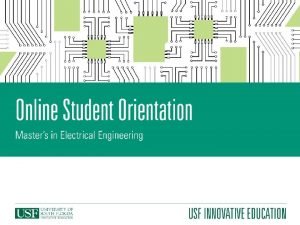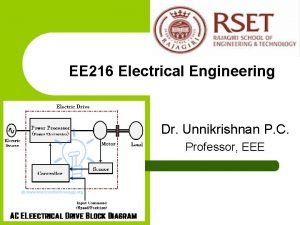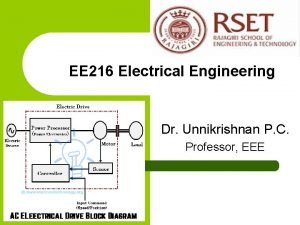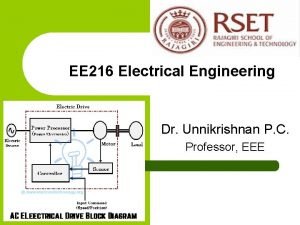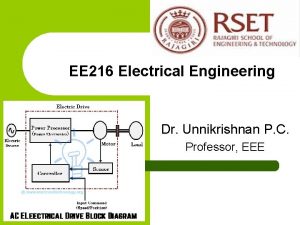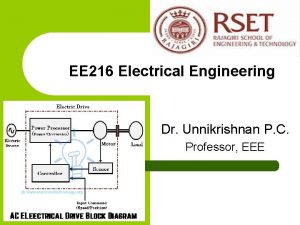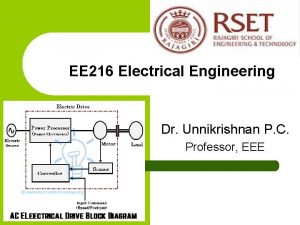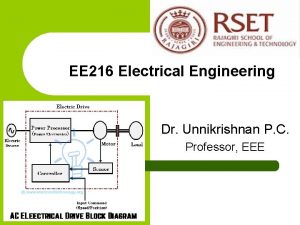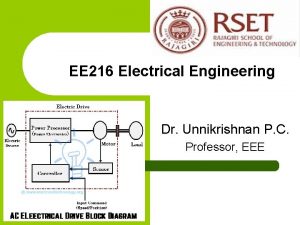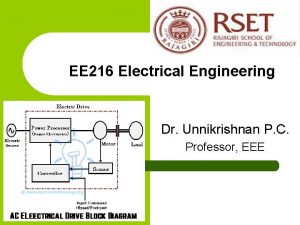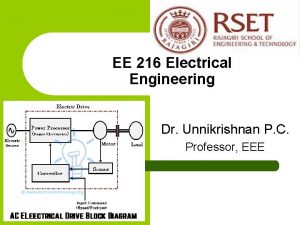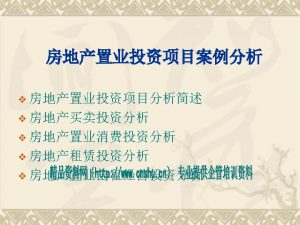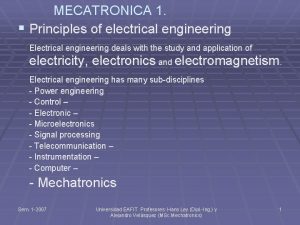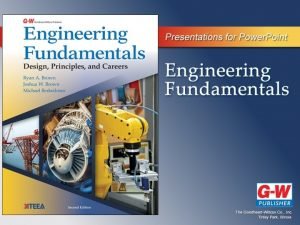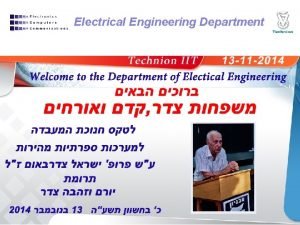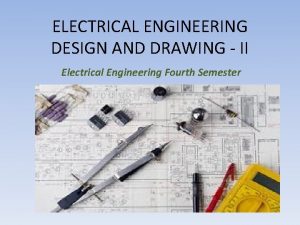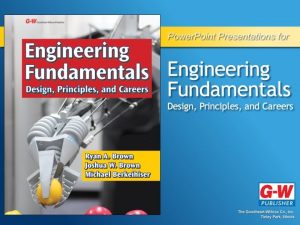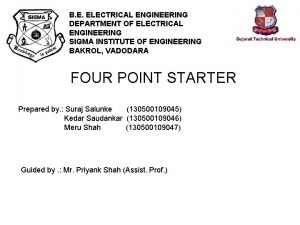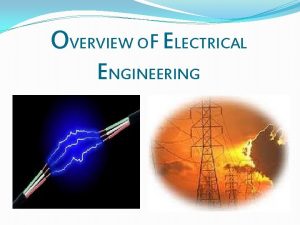EE 216 Electrical Engineering Dr Unnikrishnan P C





















- Slides: 21

EE 216 Electrical Engineering Dr. Unnikrishnan P. C. Professor, EEE

Torque •

Horse Power •

Torque-Slip Equation

Torque-Slip Characteristics

Torque-speed characteristics Typical torque-speed characteristics of induction motor

Power losses in Induction Machines • Copper losses – Copper loss in the stator (PSCL) = I 12 R 1 – Copper loss in the rotor (PRCL) = I 22 R 2 • Core loss (Pcore) • Mechanical power loss due to friction and windage • How this power flow in the motor?

Power Flow in Induction Motor

Power Relations

Induction Generator • Suppose that an induction machine is coupled with the prime mover whose speed can be controlled. • If the speed of the prime mover is increased such that the slip becomes negative • As Slip becomes negative, the rotor current and rotor emf attains negative value. • The prime mover torque becomes opposite to electric torque.

Induction Generator …… • Induction generators are often used in wind turbines and some micro hydro installations due to their ability to produce useful power at varying rotor speeds. • Induction generators are mechanically and electrically simpler than other generator types. • They are also more rugged, requiring no brushes or commutators.

Example A 208 -V, 10 hp, four pole, 60 Hz, Y-connected induction motor has a full-load slip of 5 percent 1. What is the synchronous speed of this motor? 2. What is the rotor speed of this motor at rated load? 3. What is the rotor frequency of this motor at rated load? 4. What is the shaft torque of this motor at rated load?

Solution 1. 2. 3. 4.

Example A 480 -V, 60 Hz, 50 -hp, three phase induction motor is drawing 60 A at 0. 85 PF lagging. The stator copper losses are 2 k. W, and the rotor copper losses are 700 W. The friction and windage losses are 600 W, the core losses are 1800 W, and the stray losses are negligible. Find the following quantities: 1. 2. 3. 4. The air-gap power PAG. The power converted Pconv. The output power Pout. The efficiency of the motor.

Solution 1. 2. 3.

Solution 4.

Example A two-pole, 50 -Hz induction motor supplies 15 k. W to a load at a speed of 2950 rpm. 1. What is the motor’s slip? 2. What is the induced torque in the motor in N. m under these conditions? 3. What will be the operating speed of the motor if its torque is doubled? 4. How much power will be supplied by the motor when the torque is doubled?

Solution 1. 2.

Solution 3. In the low-slip region, the torque-speed curve is linear and the induced torque is direct proportional to slip. So, if the torque is doubled the new slip will be 3. 33% and the motor speed will be 4.

Question? • Q: How to change the direction of rotation? • A: Change the phase sequence of the power supply.

Question? • Q: Why rotor core loss in a three phase induction motor negligible? • A: Usually we operate motor at slip in the range 0. 04 ~ 0. 06, thus for a stator frequency of 50 Hz , rotor frequency is around 2~3 Hz. As core losses are proportional to square of frequency (Eddy current losses) or proportional to frequency ( Hysteresis losses) , therefore the value of the Core loss is negligible for rotor.
 Analogy between electric and magnetic circuits
Analogy between electric and magnetic circuits Fundamental of electrical engineering
Fundamental of electrical engineering What is estimation in electrical engineering
What is estimation in electrical engineering Newton raphson method electrical engineering
Newton raphson method electrical engineering Elektro vektor
Elektro vektor Clemson ece lab manual
Clemson ece lab manual Fau electrical engineering flowchart
Fau electrical engineering flowchart Electrical engineering
Electrical engineering Electrical engineering kfupm
Electrical engineering kfupm Tel aviv university electrical engineering
Tel aviv university electrical engineering Lina lehn
Lina lehn Klipsch school of electrical and computer engineering
Klipsch school of electrical and computer engineering Electrical engineering notation
Electrical engineering notation Electrical engineering chula
Electrical engineering chula Keɪɒs
Keɪɒs Principles and applications of electrical engineering
Principles and applications of electrical engineering Electrical engineering has many subdisciplines
Electrical engineering has many subdisciplines Electrical engineering environmental issues
Electrical engineering environmental issues Electrical engineering fundamentals 66712 pdf
Electrical engineering fundamentals 66712 pdf Louisiana tech electrical engineering
Louisiana tech electrical engineering Usf canvas
Usf canvas George washington university electrical engineering
George washington university electrical engineering

